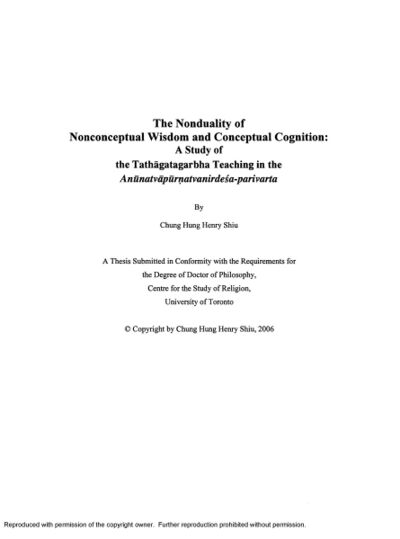The Nonduality of Nonconceptual Wisdom and Conceptual Cognition: A Study of the Tathāgatagarbha Teaching in the Anūnatvāpūrṇatvanirdeśa-parivarta
< Books
| (6 intermediate revisions by the same user not shown) | |||
| Line 1: | Line 1: | ||
{{Book | {{Book | ||
| + | |BookPerson={{Book-person | ||
| + | |PersonPage=Shiu, H. | ||
| + | |PersonName=Henry C.H. Shiu | ||
| + | }} | ||
|FullTextRead=No | |FullTextRead=No | ||
|TextTranslated=Texts/Anūnatvāpūrṇatvanirdeśaparivarta | |TextTranslated=Texts/Anūnatvāpūrṇatvanirdeśaparivarta | ||
| Line 5: | Line 9: | ||
*{{i|Abbreviations|vi}}<br><br> | *{{i|Abbreviations|vi}}<br><br> | ||
| − | *{{i|Introduction|1}} | + | *{{i|Introduction|1}}<br><br> |
<center>'''PART ONE:'''</center> | <center>'''PART ONE:'''</center> | ||
<center>'''The ''Tathāgatagarbha'' in Relation to Other Mahāyāna Teachings'''</center> | <center>'''The ''Tathāgatagarbha'' in Relation to Other Mahāyāna Teachings'''</center> | ||
| Line 14: | Line 18: | ||
*{{i|Chapter Three: The ''Anūnatvāpūrṇatvanirdeśa-parivarta''|70}} | *{{i|Chapter Three: The ''Anūnatvāpūrṇatvanirdeśa-parivarta''|70}} | ||
*{{i|Chapter Four: The Main Themes and a Structural Analysis of the ''AAN''|88}} | *{{i|Chapter Four: The Main Themes and a Structural Analysis of the ''AAN''|88}} | ||
| − | *{{i|Chapter Five: The Notion of "No Increase and No Decrease" in Mahāyāna Scriptures|122}}<br><br> | + | *{{i|Chapter Five: The Notion of "No Increase and No Decrease" in Mahāyāna<br> Scriptures|122}}<br><br> |
<center>'''PART THREE:'''</center> | <center>'''PART THREE:'''</center> | ||
<center>'''The ''AAN'' and Other ''Tathāgatagarbha'' Sūtras'''</center> | <center>'''The ''AAN'' and Other ''Tathāgatagarbha'' Sūtras'''</center> | ||
| Line 20: | Line 24: | ||
*{{i|Chapter Seven: The ''AAN'' and the ''Śrīmālāsiṃhanādasūtra''|153}} | *{{i|Chapter Seven: The ''AAN'' and the ''Śrīmālāsiṃhanādasūtra''|153}} | ||
*{{i|Chapter Eight: The ''AAN'' and the ''Aṅgulimālyasūtra''|161}} | *{{i|Chapter Eight: The ''AAN'' and the ''Aṅgulimālyasūtra''|161}} | ||
| − | Chapter Nine: The AAN and the | + | *{{i|Chapter Nine: The ''AAN'' and the ''Mahāparinirvāṇasūtra''|168}} |
| − | Chapter Ten: Other | + | *{{i|Chapter Ten: Other ''Sūtras'' on the ''Tathāgatagarbha'' Teaching|176}} |
| − | Chapter Eleven: The Problems of Dating the | + | *{{i|Chapter Eleven: The Problems of Dating the ''Sūtras''|180}}<br><br> |
| − | + | <center>'''PART FOUR:'''</center> | |
| − | PART FOUR: | + | <center>'''The ''AAN'' and Other ''Tathāgatagarbha'' Treatises'''</center> |
| − | The | + | *{{i|Chapter Twelve: The ''AAN'' and the ''Ratnagotravibhāga''|185}} |
| − | Chapter Twelve: The AAN and the | + | *{{i|Chapter Thirteen: The ''AAN'' and the ''Dasheng fajie wuchabie lun''|202}} |
| − | Chapter Thirteen: The AAN and the Dasheng fajie wuchabie | + | *{{i|Chapter Fourteen: The ''AAN'' and the ''Dasheng qixin lun''|209}} |
| − | Chapter Fourteen: The AAN and the Dasheng qixin | + | *{{i|Chapter Fifteen: The ''AAN'' and the ''Foxing lun''|239}} |
| − | Chapter Fifteen: The AAN and the Foxing | + | *{{i|Conclusion|255}}<br><br> |
| − | Conclusion | + | <center>'''APPENDICES:'''</center> |
| − | APPENDICES: | + | *{{i|Appendix I: English translation of the ''Foshuo buzeng bujian jing''|264}} |
| − | Appendix I: English translation of the Foshuo buzeng bujian | + | *{{i|Appendix II: Bodhiruci, the Translator of the ''AAN''|282}} |
| − | Appendix II: Bodhiruci, the Translator of the | + | *{{i|Bibliography|306}} |
| − | Bibliography | + | |StopPersonRedirects=No |
|AddRelatedTab=No | |AddRelatedTab=No | ||
}} | }} | ||
Latest revision as of 15:07, 28 July 2023
Abstract
Although the doctrine of tathāgatagarbha can be traced to the teaching of an innately pure luminous mind (prakṛtiś cittasya prabhāsvarā) in early Buddhist teachings, the Anūnatvāpūrṇatvanirdeśa-parivarta (AAN) is often considered one of the earliest Buddhist scriptures that explicitly expound the teachings of the tathāgatagarbha.
The central message of the AAN focuses upon the non-increase and non-decrease nature of the dharmadhātu. This brings out the idea of the dharmadhātu as a totality which transcends all dualistic notions. Translated into Chinese by Bodhiruci in 525 CE, the AAN is now extant only in Chinese translation (Taishō no. 668). Unfortunately, no serious studies have ever been conducted on this sūtra in Western scholarship. The precise relationship between the tathāgatagarbha and the two Mahāyāna traditions, Madhyamaka and Yogācāra, is also worth investigating in detail. The thesis will argue that the tathāgatagarbha is not a separate school in Indian Buddhism. It will then study the historical issues relating to the AAN, followed by a philosophical investigation of its teachings. The thesis will also undertake an "external" consideration of the doctrinal relationship between the AAN and a number of sūtras and śāstras. It will also incorporate a study of Bodhiruci (菩提流支), of the Northern Wei (北魏) dynasty, who translated the AAN into Chinese, as well as the first complete English translation of the AAN from its extant Chinese version.
This study may provide an alternative view on the tathāgatagarbha theory. The thesis will argue that the tathāgatagarbha is referring to be an aspect of all experiences. This means that all beings are by nature having a dimension of the mind not fully realized, and it is yogic meditative practices that enable the practitioners to develop an awareness of the enlightenment which is always implicit in our consciousness.
| Citation | Shiu, Henry. "The Nonduality of Nonconceptual Wisdom and Conceptual Cognition: A Study of the Tathāgatagarbha Teaching in the Anūnatvāpūrṇatvanirdeśa-parivarta." PhD diss., University of Toronto, 2005. |
|---|---|

